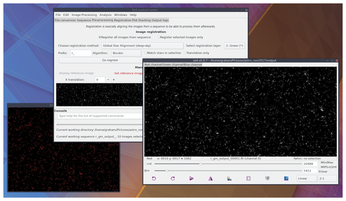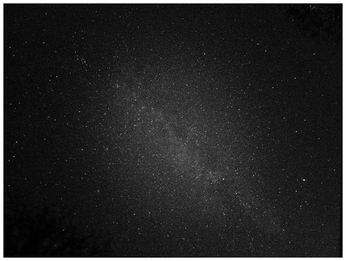FOSSPicks
Siril 0.9.7
Astronomy and Linux often go hand in hand. It can be found controlling the largest and the smallest telescopes and is just as happy number crunching vague signals into planets orbiting a distant sun as it is guiding your personal telescope to the Horsehead Nebula in your backyard. There's plenty of open source astronomy software to choose from too, taking you from the photorealism of the Stellarium planetarium to the fully four-dimensional space exploration of Celestia. Although Linux has a constellation of brilliant applications for processing photos, there has never been a decent application for processing a sequence of space photographs to create a single image … drum roll … until now. And Siril is awesome.
Many problems befall amateur astronomy photography, but the two principle problems can't be solved: The night sky is dark, and the Earth is rotating on its axis. Because the night sky is dark, photographs of space need to have long exposures. But because the Earth is rotating, unless you move the camera perfectly to compensate, the astronomical objects you're imaging will move to smear across your photograph. The only solution is to take shorter exposures, reducing the light hitting your lens, making images darker and the background noise easier to see. If you take several of these images, known as a stack, and then align and process them with some clever algorithms designed to tell the difference between the stardust and the CMOS pollution, you can create a single strong image that is greater than the sum of its parts. This is what Siril does.
Siril imitates a left-right wizard stepping you through the entire process, although you can skip steps at any time. First, you need the images. These can be from a camera connected to a telescope, but they could equally be from your phone sitting atop your car. See the above image for proof. Set a high ISO and RAW image output if you can and import these as a sequence into Siril. These are first converted to FITS or SER files, useful for high bit depths or importing videos, before being manipulated into a sequence by Siril. First, a little pre-processing can be used to darken and remove as much thermal noise as possible before Siril's incredibly smart alignment algorithm detects and removes the effects of the Earth's rotation from your sequence of images. Depending on the size and number of your images, as well as the algorithm you select, this can take either a few seconds or a full kettle's worth of minutes. Finally, the images are stacked and processed with a selection of noise-reducing and star or planetary detail-enhancing filters. These will further extract the background noise and attempt to detect color outside of local atmospheric conditions; the process is similar to creating an HDR image in something like Hugin. After tweaking, a final output can be generated with some patient parameter tweaking, some of which has real-time feedback, and many difficult control points and values to change; however, patience is always rewarded with stellar photography.
Project Website
https://free-astro.org/index.php/Siril
 Siril is complex, but you can get by with adjusting values and checking the output. Fortunately, you also can access excellent online and PDF manuals.
Siril is complex, but you can get by with adjusting values and checking the output. Fortunately, you also can access excellent online and PDF manuals.
 Taken on a phone, this image is the result of Siril processing 10 three-second exposures of the sky (ISO 3200).
Taken on a phone, this image is the result of Siril processing 10 three-second exposures of the sky (ISO 3200).
Space adventure
Pioneer
Like the Voyager 2 space probe, the game Pioneer has been around for a long time. It hasn't quite been around since 1977 when the probe was launched, but 2006 is an epoch in open source gaming. Also like Voyager, Pioneer is now interstellar and based on a technology from a previous generation, starting life as an attempt to bring something of the then-neglected Frontier – Elite 2, a 16-bit-era game – to Linux and open source. David Braben's Frontier was remarkable, taking the infinitely large open universe of Elite and populating it with curves, textures, missions, more craft, and a much richer universe. Braben's great genius has always been combining procedurally generated space with enough humanity to warm up the place; he did it with the star and planet names in Elite, with the human contacts in the Frontier games, and from terrain generation to the AI interaction in his modern creation, Elite Dangerous. Pioneer does this too.
Pioneer captures the spirit of those original games alongside the cold hard vacuum of space. Classical music fills the communal space stations and the game sticks rigidly to the Newtonian flight model of Frontier 2. Although there's no multiplayer, the universe is a combination of procedurally generated systems and real systems. One of the start locations is Barnard's Star, for example. However, Pioneer isn't a copy. It's simply inspired by the same values as its models and offers a very similar game style in a completely new universe. Fly, taxi, trade, fight, upgrade, and explore the beautifully rendered 3D universe. If you were a fan of the originals, you'll feel right at home. And if you've never flown in 1980s space, climb aboard, Commander Jameson!
Project Website
Buy this article as PDF
(incl. VAT)
Buy Linux Magazine
Subscribe to our Linux Newsletters
Find Linux and Open Source Jobs
Subscribe to our ADMIN Newsletters
Support Our Work
Linux Magazine content is made possible with support from readers like you. Please consider contributing when you’ve found an article to be beneficial.

News
-
TUXEDO Computers Unveils Linux Laptop Featuring AMD Ryzen CPU
This latest release is the first laptop to include the new CPU from Ryzen and Linux preinstalled.
-
XZ Gets the All-Clear
The back door xz vulnerability has been officially reverted for Fedora 40 and versions 38 and 39 were never affected.
-
Canonical Collaborates with Qualcomm on New Venture
This new joint effort is geared toward bringing Ubuntu and Ubuntu Core to Qualcomm-powered devices.
-
Kodi 21.0 Open-Source Entertainment Hub Released
After a year of development, the award-winning Kodi cross-platform, media center software is now available with many new additions and improvements.
-
Linux Usage Increases in Two Key Areas
If market share is your thing, you'll be happy to know that Linux is on the rise in two areas that, if they keep climbing, could have serious meaning for Linux's future.
-
Vulnerability Discovered in xz Libraries
An urgent alert for Fedora 40 has been posted and users should pay attention.
-
Canonical Bumps LTS Support to 12 years
If you're worried that your Ubuntu LTS release won't be supported long enough to last, Canonical has a surprise for you in the form of 12 years of security coverage.
-
Fedora 40 Beta Released Soon
With the official release of Fedora 40 coming in April, it's almost time to download the beta and see what's new.
-
New Pentesting Distribution to Compete with Kali Linux
SnoopGod is now available for your testing needs
-
Juno Computers Launches Another Linux Laptop
If you're looking for a powerhouse laptop that runs Ubuntu, the Juno Computers Neptune 17 v6 should be on your radar.


